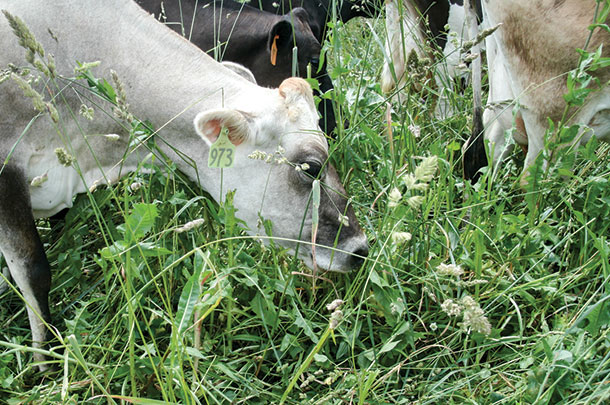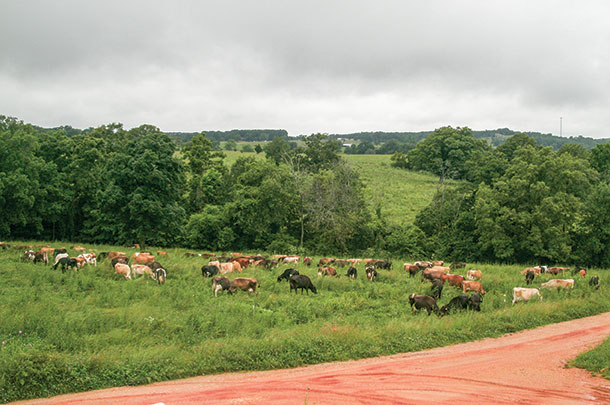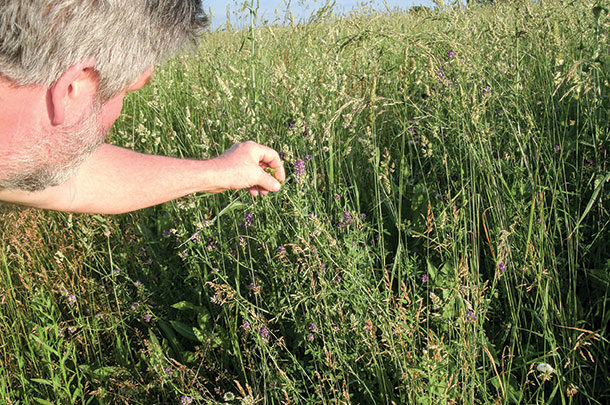While all of those management options come at a hefty price, it becomes even more critical that the practices you choose work. For one dairy grazier in south-central Missouri, working with, and not against, nature seems to be the answer.
From short to tall
Getting his start in the dairy business nearly 20 years ago, Dale Carter began his journey with 150 acres of predominantly tall fescue. Knowing how difficult it can be to milk cows on fescue, Carter began his fight against the toxic endophyte – but not at the rate he had hoped.
Carter started renovating his pastures on Cloverhill Dairy by taking out stumps, filling in gulleys, picking rock, chisel or moldboard plowing, and planting annuals for a three-year period. These pastures were planted with a summer annual mix, followed by a fall annual mix and then corn – switching out corn with oats, then wheat and then permanent pasture consecutively.
According to Carter, it takes two years to kill fescue and, even then, you’ll still get a little bit of fescue in your pastures. But that wasn’t the only problem he was running into.
Using the New Zealand or “short grass, short rotation” grazing approach, Carter found that once he finally established a new pasture, it would be gone within two or three years. He could get a decent first grazing and possibly a second grazing, but in June or July the pasture would come back with only 6 to 8 inches, and that’s all he had to finish out the year.
“We knew we had to do something different,” Carter says. “It just so happened at that time some people started talking about this ‘tall grass grazing’ or ‘mob grazing,’ and we didn’t understand it, but I started to go to a lot of seminars and pasture walks, and I listened and learned from these people.”

Instead of keeping the grasses in their vegetative state and allowing no more than a three-leaf stage, Carter found himself completely alternating his way of thinking. He went from grazing when the pastures were 8 to 12 inches or less, to grazing when it’s 18 inches or taller, and from resting the pasture 20 to 28 days, to 35 to 45 days.
“All of the rules I was accustomed to went out the window with tall grass grazing,” Carter admits. “Now, when we establish a pasture, we are getting up to 10 years before the fescue slowly starts taking over – that’s a pretty big difference.”
Joy in the diversity
Carter swears by his multi-species mixes, not only because they help build the soil fertility but also because of their assistance with weed control, their help in extending the grazing season in the early spring and late fall, and for providing good grazing during the hottest part of the year.
For his summer annual mix, Carter plants a mixture of sudangrass, sudan-sorghum cross, millet, cowpeas, soybeans, buckwheat, sunflowers, rape, berseem clover, turnips and radishes. Then for his fall/winter mix, he’ll plant rye, Austrian peas, hairy vetch, crimson clover, turnips and radishes.
To establish permanent pasture, Carter will go as far as a seven-species mix with his perennial forages. Typically, he will plant orchardgrass, perennial ryegrass, smooth brome, matua brome and some legume species such as alfalfa, white clover and red clover.

The other thing Carter emphasizes is: There are other species that end up growing in that mix. He says, “We encourage and we want some of the native or wild seed to go ahead and germinate so our pasture ends up being full of species like dock, lamb’s quarter, crabgrass, dandelions, plantain, wild chicory and things like that. The cows will eat that just as well, if not better.”
In fact, Carter recalls a time in the spring where the cows completely ignored the alfalfa he had planted and ate everything else, including many of the native species.
“I think we have been sold on the idea that we need these perfect monoculture pastures of their improved species,” Carter says. “But those native species are just as good, if not better nutritionally, than any of our improved varieties. And the diversity makes the pasture even more useful than a monoculture or two-species pasture.”
Being self-sufficient
Over time, Carter and his son, Nathaniel, have built the farm up to 640 acres and 200 crossbred cows – right where they want to be. He says the only reason they continue to purchase land is so they can become forage and feed self-sufficient.
“We want the cows out on pasture any time except for when they are walking to the barn to get milked and walking back out,” Carter says. “The only time we confine them is maybe when they’re calving or if there is an ice storm or something.
In the summer, we’ll put them on a paddock that has trees so they’ll have some shade, and the ones that don’t have shade, they’ll graze at night. In the summer and winter, we want them on pasture.”
Like many dairymen, Carter says depending on others for feed can be difficult and will probably be even more so once they transition to organic production this fall. Everything is grazed except for the rotations of corn, oats and wheat.
Those crops are harvested and stored to be ground into a feed mix for the cows. Extra forages are baled mostly as baleage for winter or in case of a drought.
“Everything starts as pasture; pasture is our number one priority. It’s what we plant everything to be; then if we have some extra or if we want to establish different pastures, we either use the leftover land for hay or cropping,” Carter says. “We are gradually reducing our need for baled forages.”
Any fescue that he does have is used for the heifers and dry cows and is winter stockpiled. He says because they are a seasonal dairy, having dry cows on stockpiled fescue is much better than feeding them hay. They are much healthier, and the calves born out on pasture are, in his words, “thrifty.”
“Looking back at where we were and where we are today – I mean some of our pastures this year were 18 to 20 inches, and the first few years we were happy to get 6 to 8 inches,” Carter quips. “Building our soil fertility up and our forage management to the point that we have all this forage, and good-quality too, is really impressive. I am proud of where we’ve been and where we are going.” ![]()
PHOTO 1: Dale Carter determines his perennial pasture is ready to graze.
PHOTO 2: Carter’s cows are grazing a native pasture.
PHOTO 3: Carter runs a crossbred herd that has been adapted to his grazing system. In this photo they are grazing a perennial mix. Photos courtesy of Dale Carter.

-
Cassidy Woolsey
- Editor
- Progressive Forage
- Email Cassidy Woolsey












